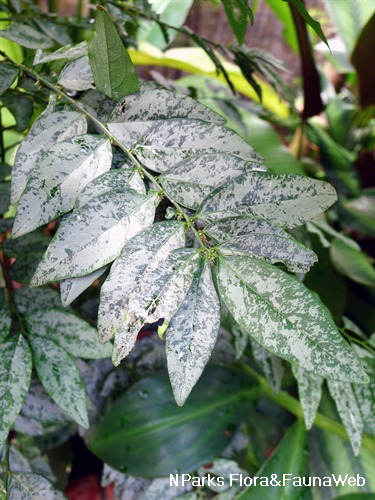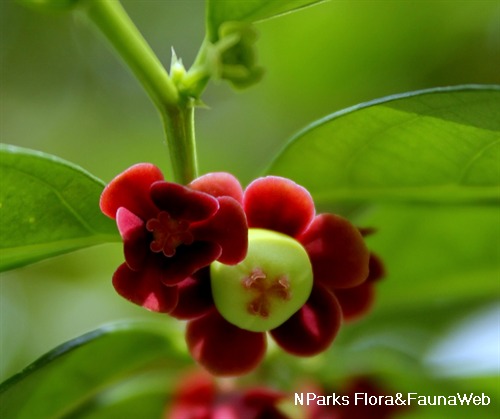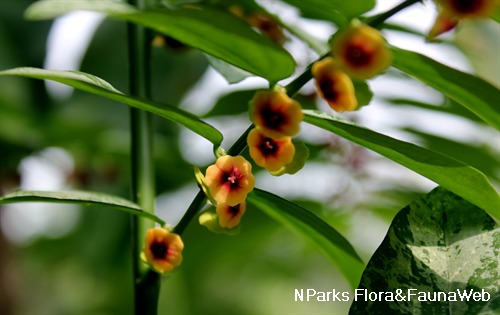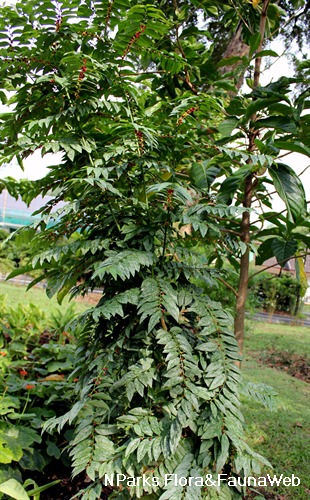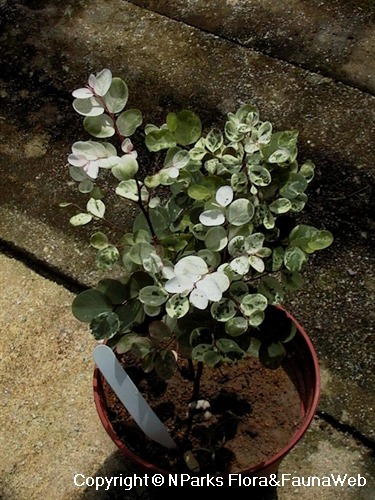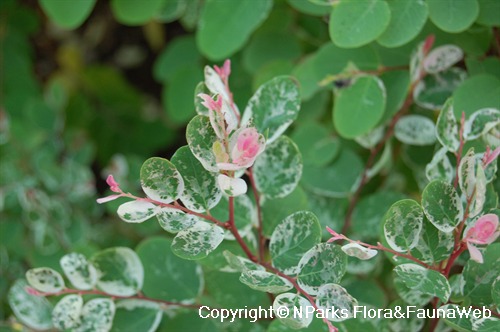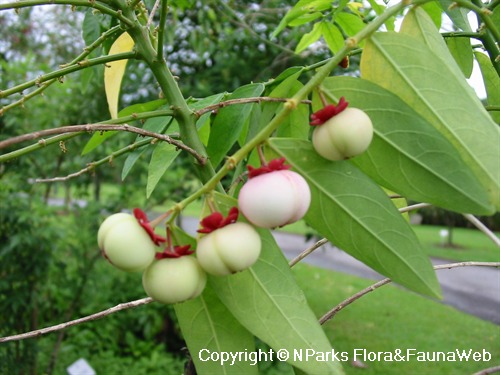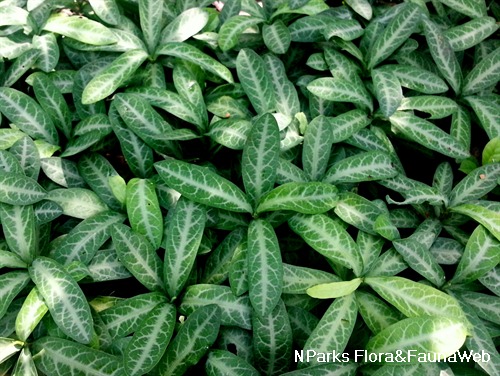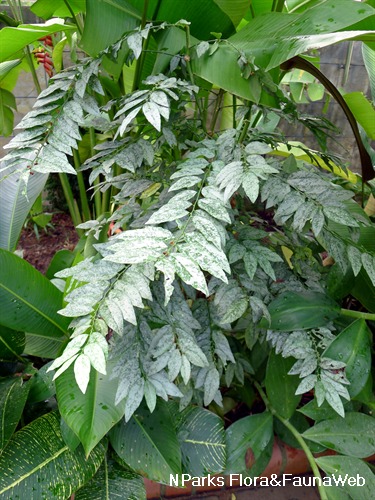
Back
Breynia androgyna (Variegated)
| Family Name: | Phyllanthaceae |
| Synonyms: | Sauropus androgynus (Variegated) |
The Variegated Cekur Manis (Breynia androgyna (Variegated)) is a shrub with leaves of white or silver variegation and fruit that resemble tiny mangosteens.This evergreen shrub is planted as a screening plant and hedges in gardens and grows best on fertile, well-drained soil in full sun to semi-shade.
Name
Classifications and Characteristics
| Plant Division | Angiosperms (Flowering Seed Plants) (Dicotyledon) |
|---|---|
| Plant Growth Form | Shrub |
| Lifespan (in Singapore) | Perennial |
| Mode of Nutrition | Autotrophic |
| Plant Shape | Shrubby |
| Maximum Height | 1 m to 3 m |
Biogeography
| Native Distribution | Of horticultural origin |
|---|---|
| Native Habitat | Terrestrial |
| Preferred Climate Zone | Tropical, Sub-Tropical / Monsoonal, Temperate |
| Local Conservation Status | Non-native (Horticultural / Cultivated Only) |
Description and Ethnobotany
| Growth Form | A slender shrub that grows up to 3 m tall, and has lateral branching. |
|---|---|
| Foliage | The leaves are oval to elliptic-shaped, measuring 4-5cm long, white/silvery variegated, grows alternately along the stems. |
| Stems | Stem is vertical and somewhat woody. |
| Flowers | The flowers are apetalous (lack petals), small and occur on the leaf axils. Female flowers have 6 red sepals surrounding a single creamy-coloured pistil, while the male flowers have 6 creamy sepals enclosing 3 reddish stamens. |
| Fruit | The fruit are white explosive capsules resembling mangosteens, with persistent red calyxes, releasing many black seeds. |
| Cultivation | This shrub grows well in full sun to semi-shade, but will produce more leaves under semi-shade. It is adapted to acidic soils and tolerates occasional flooding. Prune regularly or harvest frequently to keep the plant tidy. Provide plant with nitrogen rich fertilizer to stimulate more leaves. It is generally easy to grow. Propagation is usually by stem cuttings which root easily. |
| Etymology | The genus Breynia is named after 17th century Polish botanists Jacob Breyne and his son Johann Philipp Breyne. The specific epithet androgyna is a Latin word which means having presence of male and female flowers on the same plant. |
Landscaping Features
| Landscaping | The plant can be used in landscaping for its ornamental leaves, particularly as screening plant, hedges or container planting. |
|---|---|
| Desirable Plant Features | Ornamental Foliage, Ornamental Flowers, Ornamental Fruits |
| Landscape Uses | Flowerbed / Border, Hedge / Screening, Container Planting |
| Thematic Landscaping | Economic Garden, Naturalistic Garden |
Fauna, Pollination and Dispersal
| Seed or Spore Dispersal | Abiotic (Explosive Dehiscence) |
|---|
Plant Care and Propagation
| Light Preference | Full Sun, Semi-Shade |
|---|---|
| Water Preference | Moderate Water |
| Plant Growth Rate | Fast |
| Rootzone Tolerance | Fertile Loamy Soils, Well-Drained Soils, Acidic (low pH) Soils, Easy to Grow |
| Transplanting Tolerance | Good |
| Maintenance Requirements | Low |
| Propagation Method | Seed, Stem Cutting |
| Propagule Establishment Remarks | Stem cuttings root easily. |
Foliar
| Foliage Retention | Evergreen |
|---|---|
| Mature Foliage Colour(s) | Green - Bluish Green, Silver / Grey |
| Mature Foliage Texture(s) | Thin |
| Prominent Young Flush Colour(s) | Green - Bluish Green, Silver / Grey |
| Young Flush Texture(s) | Thin |
| Foliar Type | Simple / Unifoliate |
| Foliar Arrangement Along Stem | Alternate |
| Foliar Attachment to Stem | Petiolate |
| Foliar Shape(s) | Non-Palm Foliage (Ovate, Elliptical) |
| Foliar Venation | Pinnate / Net |
| Foliar Margin | Entire |
| Foliar Apex - Tip | Acute |
| Foliar Base | Rounded / Obtuse, Truncate / Square |
| Typical Foliar Area | Notophyll ( 20.25cm2 - 45 cm2 ) |
| Leaf Area Index (LAI) for Green Plot Ratio | 4.5 (Shrub & Groundcover - Dicot) |
Non - Foliar and Storage
| Stem Type & Modification | Herbaceous, Woody |
|---|---|
| Root Type | Underground (Fibrous Root) |
Floral (Angiosperm)
| Flower & Plant Sexuality | Unisexual Flowers , Monoecious |
| Flower Colour(s) | Red |
|---|
| Flower Grouping | Cluster / Inflorescence |
| Flower Location | Axillary |
| Flower Symmetry | Radial |
| Flowering Period | Free-Flowering |
| Flowering Habit | Polycarpic |
Fruit, Seed and Spore
| Mature Fruit Colour(s) | Red, White |
|---|---|
| Mature Fruit Texture(s) | Smooth |
| Fruit Classification | Simple Fruit |
| Fruit Type | |
| Mature Seed Colour(s) | Black |
| Seed Quantity Per Fruit | Few (1-5) |
Image Repository
Others
| Master ID | 31199 |
|---|---|
| Species ID | 5593 |
| Flora Disclaimer | The information in this website has been compiled from reliable sources, such as reference works on medicinal plants. It is not a substitute for medical advice or treatment and NParks does not purport to provide any medical advice. Readers should always consult his/her physician before using or consuming a plant for medicinal purposes. |

